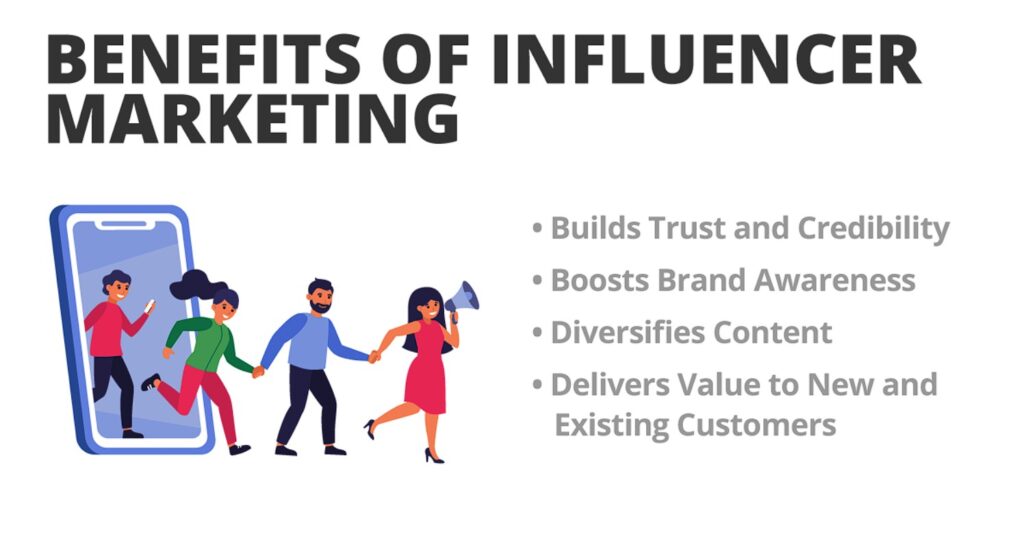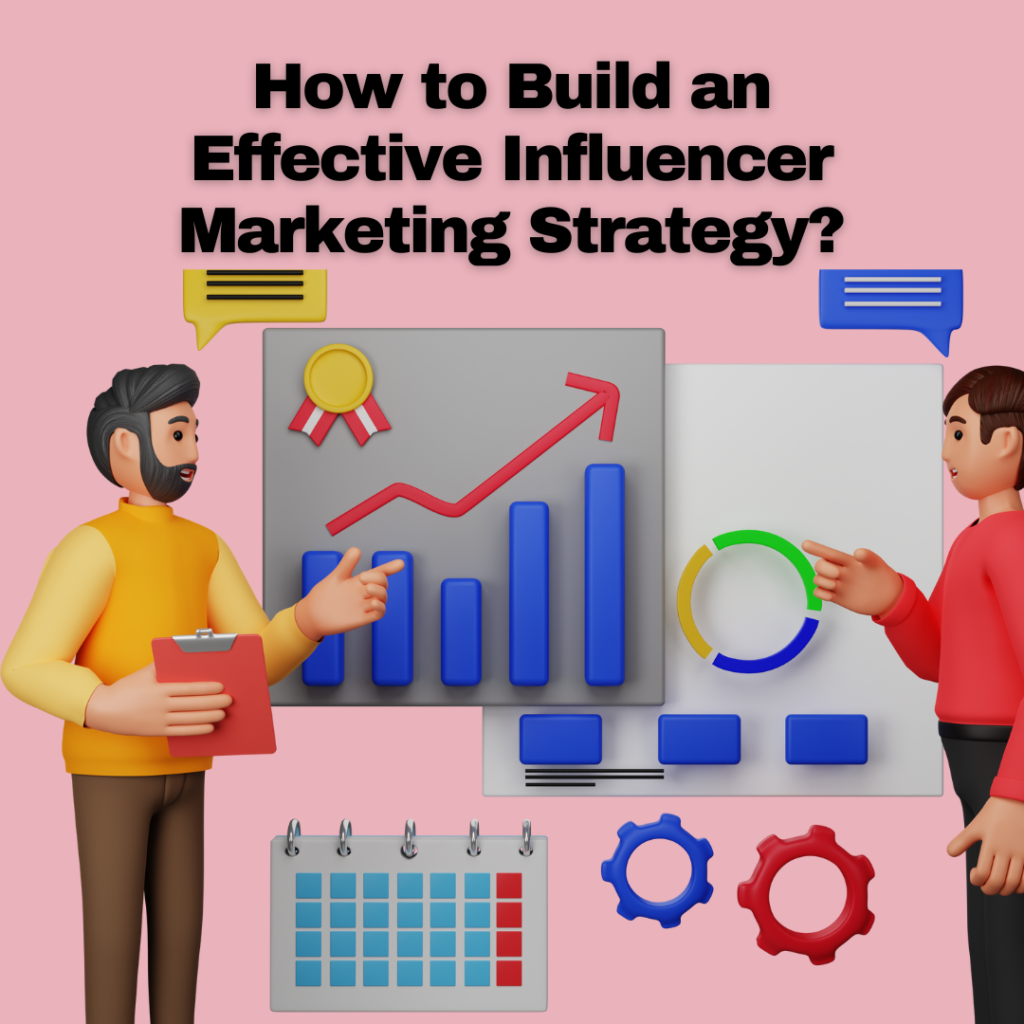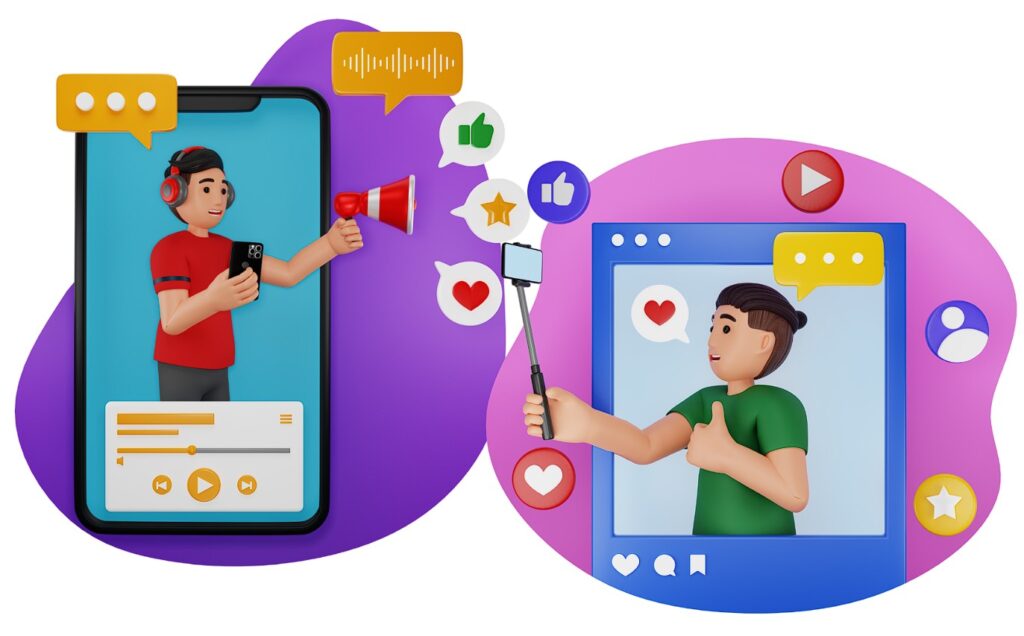Influencer marketing is the practice of brands collaborating with well-known individuals on social media to market their goods. These influencers have a loyal following who trust their opinions, so when they recommend something it feels more personal and genuine. It helps brands reach a wider audience and build trust in a more natural way than traditional ads.

Influencer Marketing vs Social Media Marketing
Scenario: A cosmetics brand wants to promote a new line of skincare products.
The brand partners with a well-known beauty influencer on YouTube. The influencer creates a “Get Ready With Me” video where they review and use the brand’s skincare products, discussing how the products work and showing their followers the results. By partnering with an influencer, the brand uses the trust the influencer has with their followers. The influencer’s recommendation can make followers more likely to try the product because they trust the influencer’s opinion.
The same brand promotes its skincare products by running Instagram ads and Facebook posts. These posts highlight product features, customer reviews and special offers. They use hashtags, tag people, and post at the best times to get more attention. The goal is to reach a wide audience, raise brand awareness, drive traffic to their website and boost sales.
Types of Influencers
Influencer marketing has evolved and now brands work with influencers of all sizes, not just celebrities or those with millions of followers. Influencers are divided into five categories based on their following size and each category can help you achieve different goals in your marketing strategy:
1.Mega Influencers (over 1 million followers) :
Mega Influencers are social media celebrities like Beer Biceps, Mr. Beast, Prajakta Kohli and Kritika Khurana. They are great for brand awareness campaigns because:
- They offer huge reach and exposure.
- Their endorsement gives instant credibility to your brand.
- They influence across multiple platforms.
- They create high-quality, professional content.
2. Macro Influencers (500k – 1 million followers):
Macro-Influencers offer a great mix of reach, credibility and professionalism. They connect well with their audience and create content that balances mass appeal with a sense of community. They’re ideal for your influencer marketing if you want:
- Wider reach for brand awareness.
- Credibility and trust.
- High-quality content.
- Professionalism and experience.
- Cross-platform influence.

3. Mid Tier Influencers (100k-500k followers):
Mid-Tier Influencers are great for balancing reach, engagement and cost. They offer:
- Broad yet targeted reach.
- Higher engagement than bigger influencers.
- Credibility and expertise in their niche.
- Creative freedom to match your brand’s voice.
4. Micro-influencers (10k-100k followers) :
Micro-Influencers are great for brands wanting to reach niche audiences. They’re known for:
- Expertise in specific niches.
- Higher engagement and stronger connections with followers.
- Authenticity and trustworthiness.
- Being cost-effective for smaller campaigns.
5. Nano Influencer (1k-10k followers):
Nano Influencers may have smaller followings, but they offer big value. They’re great for:
- Building authentic relationships and high engagement.
- Trust-building with niche audiences.
- Being affordable and cost-effective.
- Creating genuine content that feels real, not like an ad.
- Offering precise targeting for niche markets.
Their strong engagement (over 4%) makes them powerful for driving real results.
Benefits of Influencer Marketing in 2025:

For Influencers:
Build Trust: Influencers connect with people who trust them, helping them grow their audience.
Grow Following: Working with brands helps influencers reach new people who like their content.
For Brands:
Spread the Word: Influencers help tell more people about a brand’s products.
Make Strong Friendships: Brands work with influencers who share similar values, building lasting relationships.
Sell More: Influencers drive traffic to the brand’s website, increasing sales.
For Agencies:
Help Clients Grow: Agencies find the best influencers for brands, ensuring great results.
Create Big Ideas: Agencies come up with creative campaigns to get people talking about brands with influencers.
Key Trends in Influencer Marketing for 2025:
Here are some key trends in influencer marketing based on a survey of over 30 influencer marketing managers and brand strategists:
- UGC (User Generated Content): Brands are using content created by real customers like photos or videos to make their brand more authentic and connect with audiences. UGC is still a big trend in 2025.
- AI Influencers: Virtual personalities are gaining popularity. These AI influencers can engage with followers 24/7, offering brands creativity and consistent presence.
- Social Commerce: Shopping directly on social media platforms is now mainstream. Influencers are making it easier for people to buy products by linking directly to purchase options within their posts.
- LinkedIn Influencers: LinkedIn is becoming a strong platform for influencer marketing especially for B2B brands.
Click Here To Explore more about Future Trends
How to Build an Effective Influencer Marketing Strategy?
Building an effective influencer marketing strategy requires a thoughtful approach to ensure you reach the right audience and achieve your business objectives. Here’s a step-by-step guide to create a strategy that works:

1. Set Clear Goals
Brand Awareness: Are you looking to boost visibility for your brand or product?
Engagement: Do you want to increase likes, comments, shares, or other forms of interaction?
Conversions/Sales: Are you focused on driving direct sales or sign-ups?
Lead Generation: Do you want to capture contact information through forms or landing pages?
2. Identify Your Target Audience
Understand the demographics (age, location, gender etc.) of the audience you want to reach.
Research where your audience hangs out online—whether it’s Instagram, TikTok, YouTube, Twitter etc.
3. Choose the Right Influencers
Macro-Influencers: Individuals with large followings (100K+). They can offer broader reach but may have less engagement.
Micro-Influencers: Smaller followings (10K-100K), typically more engaged and authentic with higher engagement rates.
Nano-Influencers: Small but highly engaged audiences (less than 10K) often seen as relatable and trustworthy.
Focus on influencers whose followers closely match your target audience.
4. Create a Compelling Offer
Decide whether to offer free products, payment, or a commission model (e.g., affiliate marketing).
Be transparent and clear with influencers about what they will receive in exchange for their collaboration.
5. Set Your Budget
Set a budget based on the type of influencers you’re working with, your goals and your product’s value.
Don’t forget to account for influencer fees, content creation costs and any promotion fees if necessary.
6. Track Performance & Adjust
Use tracking links and unique discount codes to track the performance of your influencer campaigns.
Measure engagement metrics, click-through rates, conversions and return on investment (ROI).
Analyze what worked and refine your strategy for future campaigns.
By following these steps, you’ll create an influencer marketing strategy that is targeted, impactful and capable of driving real business results.
Influencer Marketing mistakes to avoid in 2025
In 2025, influencer marketing will continue to grow, but it’s important to avoid common mistakes to maximize your success. Here are some major mistakes to be aware of:
1.Choosing the Wrong Influencer
Pick influencers whose audience matches your target customers, not just those with big followings.
2.Focusing Only on Follower Count
Check engagement, not just follower numbers. Fake or inactive followers can change results.
3.Not Building Long-Term Relationships
Collaborating with influencers over time is better than one-time partnerships.
4.Not Tracking Results
Always monitor campaign performance to make sure it’s delivering the results you want.
5.Controlling Creativity Too Much
Let influencers create content that feels authentic to their audience instead of dictating everything.
6.Overlooking Micro-Influencers
Small influencers with highly engaged followers can be more effective than big names.
7.Ignoring Legal Rules
Make sure influencers follow the rules for sponsored content to avoid any legal issues.
8.Not Engaging After the Campaign
Stay active after the campaign ends. Engaging with followers keeps the momentum going.
The Future of Influencer Marketing

The future of influencer marketing is exciting, with even more focus on authentic connections between brands and influencers. Instead of just one-time partnerships, brands will lean into long-term relationships to build trust and credibility. Micro and nano-influencers will play a bigger role, as their smaller but highly engaged audiences are more valuable. People are looking for real, genuine content, so transparency will be crucial. As technology keeps improving, tracking and measuring the success of campaigns will get easier helping brands make smarter decisions and get even better results.
FAQS(Frequently Asked Questions)
1. What is influencer marketing?
Influencer marketing involves brands partnering with popular social media figures to promote their products. These influencers have loyal followers who trust their opinions, making it an effective way to reach a larger, engaged audience in a more personal way than traditional ads.
2.What is the difference between influencer marketing and social media marketing?
Influencer marketing focuses on collaborating with influencers to promote products, while social media marketing involves using paid ads and posts on platforms like Instagram or Facebook to raise awareness and drive sales. Influencers often provide a more authentic connection with audiences whereas social media ads target wider reach.
3.What are the key trends in influencer marketing for 2025?
Some key trends include:
User-Generated Content (UGC): Brands using content from real customers to appear more authentic.
AI Influencers: Virtual personalities that engage with followers 24/7.
Social Commerce: Making it easy to buy products directly from social media posts.
LinkedIn Influencers: A growing platform for B2B influencer marketing.
4.How do I choose the right influencer for my brand?
When selecting an influencer consider their audience demographics, content style and relevance to your brand. Choose someone whose followers match your target market and whose content aligns with your brand values. It’s important to evaluate their engagement rate and how authentic their posts are.
5.How do influencers get paid?
Influencers can be paid in several ways, including direct payment for posts, free products or affiliate commissions (where they earn a percentage of sales made through their referral links). The payment method depends on the agreement made between the brand and the influencer.
6.What is UGC (User-Generated Content) and why is it important?
User-Generated Content is content created by real customers like photos or videos, showcasing a brand’s products. It’s valuable because it feels more authentic and relatable to potential customers. UGC helps build trust and credibility for the brand and consumers are more likely to engage with content created by their peers.
7.Can influencers help with lead generation?
Yes, influencers can be an effective tool for lead generation. By providing exclusive offers or directing followers to landing pages or sign-up forms. Influencers can help capture valuable customer data which can then be used for future marketing efforts.
Want to know more about Digital Marketing?